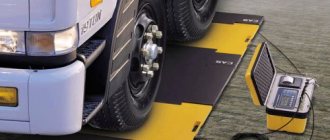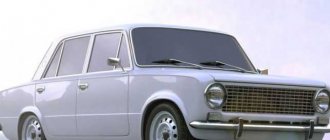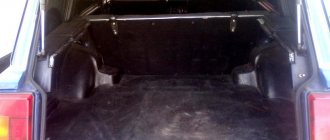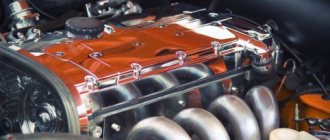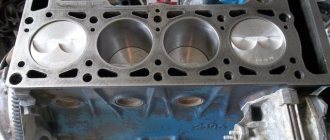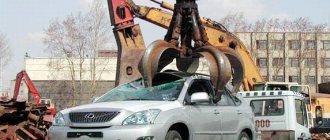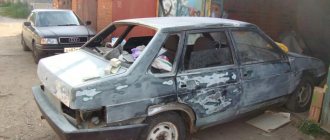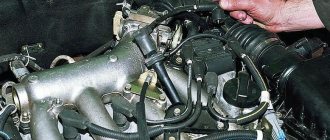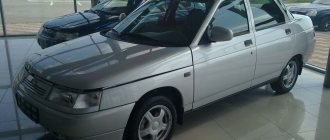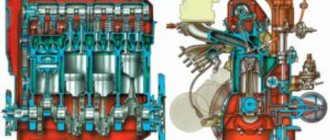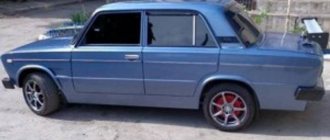VAZ car engine weight:
| Model | Working volume, cm 3 | Power, hp | Weight, kg |
| VAZ 11183-1000260 | 1596 | 82 | 112 |
| VAZ 11194-1000260 | 1390 | 89 | 112 |
| VAZ 2103-1000260 | 1450 | 71,4 | 120,7 |
| VAZ 2104-1000260 | 1450 | 68 | 120 |
| VAZ 2106-1000260 | 1570 | 74,5 | 121 |
| VAZ 21083-1000260-53 | 1500 | 69 | 127,3 |
| VAZ 2111-100026080 | 1490 | 77 | 127,3 |
| VAZ 21114-100026080 | 1596 | 81,6 | 112 |
| VAZ 21124-100026080 | 1599 | 89,1 | 121 |
| VAZ 21126-100026080 | 1597 | 98 | 115 |
| VAZ 21128-100026080 | 1796 | 105 | 117 |
| VAZ 21213-1000260 | 1690 | 78,9 | 117 |
| VAZ 21214-1000260 | 1690 | 81 | 122 |
| VAZ 2123-1000260 | 1690 | 81 | 127 |
| VAZ 2130-1000260 | 1790 | 81,8 | 122 |
Random entries - how much does it weigh:
Permission is granted to reprint and distribute materials from this site with a direct indexed link.
For the rear-wheel drive sedan VAZ-2103 (LADA 1500) or simply “troika”, the domestic manufacturer initially provided a new engine 2103 with a displacement of 1.5 liters, built on the basis of 2101. This model also used proven engines from a “kopeck” to 1 .2 liters and from VAZ-21011 by 1.3 liters. VAZ 2106 engines were produced in small quantities for the third Zhiguli model.
Engine VAZ 2103
The 1.5-liter four-cylinder in-line carburetor power unit of the VAZ 2103 received an overhead camshaft, a timing chain drive and a high engine block, which allows the installation of a crankshaft with an extended piston stroke.
Zhiguli engines often suffer from camshaft wear or the lack of a tensioner in the drive chain, which needs to be tightened every 10 thousand kilometers. If a loud knocking noise occurs in the engine, you will have to adjust the valve clearances to avoid a drop in power, increased fuel consumption, valve burnout, and other things.
Also among the disadvantages of the engine for the “troika” is the need for constant adjustment and cleaning of CO. If the engine overheats, pay attention to the pump.
If tripping occurs, you need to change the compression.
Engine tuning is possible in a wide range: from boring to compressor and turbines.
Among motorists, the VAZ-2103 engine is in good standing, compared to other units in the line. The long service life is due to the availability of spare parts and their low cost. With careful treatment of the engine and timely maintenance, the VAZ-2103 will travel not 125 thousand kilometers declared by the manufacturer, but all 180-200 thousand kilometers.
Engine VAZ 2106
The 1.6-liter VAZ 2106 engine became a continuation of the VAZ 2103 and, as a consequence, 2101. The main differences from its counterparts are in the piston with a diameter increased to 79 mm, while the engine block remained unchanged.
Weight and technical characteristics of the VAZ 2106 engine
The weight of the assembled VAZ 2106 engine is 121 kilograms. Together with the cylinder head and ignition system, the unit becomes heavier by another 19 kg, and if you add to this the gearbox with related devices, the total weight of the equipment will be 146 kg.
The technical characteristics of the engine at the time of production were advanced: engineers reworked the previous engine, increasing the cylinder diameter and increasing the power of the unit. The engine is a four-stroke, four-cylinder, in-line engine. The gasoline internal combustion engine with a capacity of 77 horsepower is equipped with a carburetor, but injection models were also produced that have slightly less power - only 75 hp. With.
Motor 2106 is the most powerful mass-produced small-displacement power unit produced in the USSR.
In 1984, Bulgarian engineers released a diesel version of the engine, but they failed to achieve an increase in power, although the weight of the VAZ 2106 engine increased by 10 kilograms.
Structural elements of the VAZ 2106 engine
Having found out how much the VAZ 2106 engine weighs, let’s look at the design features of the unit:
- Fuel is supplied to internal combustion engines equipped with carburetors by a mechanical diaphragm-type pump. From the carburetor, the air-fuel mixture enters the intake manifold, and from there into the combustion chambers. Exhaust gases are discharged as standard - through a muffler.
- The engine oil circuit is combined: depending on the type of unit, it is capable of supplying lubricant both by splashing and under pressure.
- The engine ignition system was initially a contact system - equipped with a voltage distributor with a breaker, but later it acquired a Hall sensor and an electronic switch.
- The timing mechanism is driven by a chain - after the failure with the belt drive, the development engineers returned to the traditional design.
- The engine cooling system is classic liquid, equipped with a thermostat. The refrigerant circulates through the channels, removing excess heat from the hot elements and transferring it to the stove in the cabin, as well as to the radiator for cooling.
Cooling circuit of the “six”.
The power unit, gearbox and clutch are mounted on three shock-absorbing supports, which not only take on the entire mass of the mechanisms, but also soften the loads that arise when the engine is running and the vehicle is moving.
What internal combustion engine models were still installed on the “six”
VAZ-21061 (LADA 1500 S) cars were equipped with a VAZ 2103 power unit with a volume of 1.45 liters. The cars were produced for export to the Netherlands, Canada and England, as well as for the country’s domestic market (in the latter case, they were sometimes equipped with a simplified cooling system - without an electric fan). The diameter of the engine cylinders is 3 mm smaller than that of the “native” version, so it has a different cylinder-piston group and the cylinder block itself.
The VAZ-21063 (LADA 1300 SL) model was equipped with VAZ-21011 engines. The installations had several design differences from 2106:
- smaller volume (only 1.3 l);
- The internal combustion engine was equipped with an oil pressure sensor;
- the piston stroke was 1.4 cm shorter, and accordingly the dimensions of the crankshaft, timing drive and cylinder block were also changed;
- Instead of an impeller with a drive belt, most engines were equipped with an electric fan.
Production of VAZ-21011 power units was discontinued in 1994.
Tuning rules
The main goal of high-quality tuning is improved engine performance. And the desired result can be achieved using the following methods:
- boosting the engine;
- chip tuning;
- replacing the ignition system with a more powerful one.
The most difficult and one of the most expensive procedures is increasing the diameter of the cylinders and the piston stroke. The weight of the VAZ car does not change, but the output power increases significantly. The best solution in this case is to replace the cylinders, which will be both easier and cheaper to install. The overall dimensions of the components will change very slightly and will not affect the ride quality in any way. Dimensions make themselves felt only when the vehicle is overcrowded or faulty.
Another effective tuning method is to improve the dynamic performance of the engine, achieved in the following way:
- the weight of the crankshaft and connecting rod-piston system is reduced;
- adjustment of gear ratios;
- adjustment of electronic systems.
The torque of the car will not change much from such actions; the power will increase, but only slightly.
Radical methods can come to the rescue, allowing those who wish to carry out in-depth tuning.
It consists in selecting a special crankshaft to replace the factory unit. This will allow you to change the car, practically reduce the ground clearance, and increase power. After all the necessary elements have been replaced, the vehicle as a whole is repaired and debugged.
Chip tuning is a relatively new modernization method that allows you to change parameters without mechanical intervention using special software. How much the engine weighs and when it was produced does not matter. The system will cope with any, even the most difficult, circumstances.
Replacing the ignition system belongs to the category of progressive tuning techniques. The best solution is a block called non-contact and allows you to significantly gain in power.
Experimenting with your own car is, of course, good, however, when deciding on the next modification, you need to think about whether they will be the last thing that the vehicle will finish off . The range of experiments is wide, so there is no need to rush. It’s better to think carefully and choose what will really come in handy.
This is interesting: What is a drive belt for?
History of creation and advantages of the VAZ 2106
At the time of its creation and many years later, the “six” was an advanced car. The model based on the 2103 acquired not only an improved and more powerful motor, but also a new electrical circuit, as well as an improved external design. The car was capable of reaching a significant speed for those times - 150 km/h , while the acceleration time from zero to hundreds was only 16 seconds.
The design power of the internal combustion engine was 80 horsepower, but in practice the developers were unable to achieve this value, because the design of the original engine (VAZ 2103) was designed for a smaller volume of combustion chambers.
The salon has also changed in a positive way:
- a tachometer appeared on the instrument panel;
- sound insulation has been improved;
- the seats now have headrests and a textured surface;
- The interior has also become significantly more comfortable compared to the previous model, in which the main emphasis was on practicality.
The legendary VAZ 2106 Brezhnev.
The unique VAZ 2106 car with the popular name “Half six” was produced in 1997 on a special order for L. I. Brezhnev. The model had a slightly modified hood, and also installed seats and a radiator from the “Seven”, which at that moment was still at the development stage.
GAZ-2495 Volga 4x4
— all-wheel drive model of the serial Volga. The SUV used components and assemblies of GAZ-69 and UAZ... Read more...
ZMZ-402 engines are unpretentious in operation and quite easy to maintain. These are gasoline, carburetor, 4-cylinder in-line engines. They were installed mainly on Volga and Gazelle cars. Over the years of production, 6,125,136 copies of the engine were produced.
Modifications of the ZMZ 402 series engine:
- ZMZ-402.10 as the main basic option for AI-92 gasoline;
- ZMZ-4021.10, consuming A-76 fuel (80);
- ZMZ-4022.10, which has a new type of ignition, the so-called pre-chamber-torch;
- ZMZ-4025.10 - designed for cars of the Gazelle family (same 4021.10);
- ZMZ-4026.10 - designed for cars of the Gazelle family (same 402.10).
Specifications
| Production | ZMZ |
| Engine make | ZMZ-402 |
| Years of manufacture | 1981-2006 |
| Cylinder block material | aluminum |
| Supply system | carburetor |
| Type | in-line |
| Number of cylinders | 4 |
| Valves per cylinder | 4 |
| Piston stroke, mm | 92 |
| Cylinder diameter, mm | 92 |
| Compression ratio | 8.2 6.7* |
| Engine capacity, cc | 2445 |
| Engine power, hp/rpm | 100/4500 90/4500* |
| Torque, Nm/rpm | 182/2500 172/2500* |
| Fuel | 92 76* |
| Environmental standards | — |
| Engine weight, kg | 181 184** |
| Fuel consumption, l/100 km - city - highway - mixed. | 13.5 — — |
| Oil consumption, g/1000 km | up to 100 |
| Engine oil | 5W-30 / 5W-40 / 10W-30 / 10W-40 / 15W-40 |
| How much oil is in the engine, l | 6 |
| When replacing, pour, l | 5.8 |
| Oil change carried out, km | 10000 (better 5000) |
| Engine operating temperature, degrees. | |
| Engine life, thousand km - according to the plant - in practice | 200 * - for engines ZMZ 4021.10 and 4025.10 ** - engine weight for GazelleMaintenance ZMZ-402
View of ZMZ-402 on the left: 1 – starter; 2 – starter traction relay; 3 – oil line; 4 – fuel pump; 5 – engine support bracket; 6 – sensor for emergency oil pressure lamp; 7 – oil filter; 8 – crankshaft pulley; 9 – water pump pulley; 10 – water pump; 11 – thermostat; 12 – coolant temperature indicator sensor; 13 – fine fuel filter; 14 – spark plug; 15 – ignition distributor; 16 – pusher cover; 17 – ignition distribution drive and oil pump. View of ZMZ-402 on the right: 1 – crankshaft pulley; 2 – oil pressure indicator sensor; 3 – exhaust manifold; 4 – oil sump; 5 – coolant drain valve; 6 – cylinder head; 7 – inlet pipe; 8 – carburetor; 9 – oil filler plug; 10 – rocker cover; 11 – thermostat; 12 – water pump pulley; 13 – generator. |
| ZMZ-24D / ZMZ-402 | |
| Engine ZMZ-4022.10 from the exhibition of the Museum of History of OJSC GAZ, Nizhny Novgorod | |
| Manufacturer | ZMZ |
| Type | Gasoline, carburetor |
| Volume | 2445 cm 3 |
| Maximum power | 100 l. With. , at 4500 rpm |
| Maximum torque | 182 Nm, at 1800-2200 rpm |
| Configuration | in-line, 4-cylinder. |
| Cylinders | 4 |
| Valves | 8 |
| Cylinder diameter | 92 mm |
| Piston stroke | 92 mm |
| Compression ratio | 8,2:1 |
| Supply system | carburetor K-129V |
| Cooling | liquid |
| Valve mechanism | OHV |
| Cylinder block material | aluminum |
| Cylinder head material | aluminum |
| Resource | 200 thousand km. |
| Clock (number of clock cycles) | 4 |
| Cylinder operating order | 1-2-4-3 |
| Recommended fuel | gasoline AI-92 / A-76 |
- a family of gasoline 4-cylinder automobile engines produced by JSC Zavolzhsky Motor Plant. Although the designation itself was introduced in the 1980s, the engine itself, with subsequent upgrades, has been produced since 1968 (ZMZ-24D).
Read more: Top physics games on PC
The engine family was used on cars from Gorky Automobile, GAZelle, as well as minibuses “Latvia” from the Riga Bus Factory and partially on cars from the Ulyanovsk Automobile Plant.
How much does the VAZ-2101 weigh? Weight of the VAZ-2101 body and engine
How much the VAZ-2101 weighs is affected by the wear of metal parts, the presence of additional body kit and gas equipment. It is worth noting that the vast majority of modern sedans are equipped with a monocoque body configuration. “Kopeyka” in this case is no exception. This design is a steel box, inside of which there is a compartment for passengers, driver and luggage. In addition, the body carries the working components and assemblies of the vehicle.
Design features
Regardless of how much the VAZ-2101 weighs, the car body experiences not only static stress from the equipment installed on it, but is also forced to resist its effects under dynamic load. This property of the box is called torsional rigidity. On the car in question, this figure is approximately 7300 Nm/deg.
This technical parameter is significantly influenced by the condition of the bottom, roof, and thresholds. This is due to the fact that these elements are interconnected by the front panel. In addition, the strength characteristics and geometry of the body depend on the integrity of the door pillars, window panels and luggage compartment cross member. You can check the correct symmetry and general condition of the machine yourself. To do this, take the actual dimensions of the frame and compare them with the parameters specified in the car repair manual.
Load distribution
From the above it follows that the fatigue of the VAZ-2101 body directly affects the state of the control points for fixing units and components, and is also manifested in the correct geometry of its front, rear and side openings.
When moving (in dynamics), the distribution of loads on the frame occurs as follows:
- From the front suspension parts, vibration and mechanical moments are transformed to the cross member with subsequent transfer to the sub-engine frame part.
- Next, the force is transferred to the surface of the mudguards and the front shield, which are classified as load-bearing body elements.
- In the rear, a similar picture occurs in a more simplified form. There are no motor mounts involved here; the transition goes straight from the suspension to the car frame.
Material of manufacture
With this configuration of the body and suspension, the frame material plays a significant role in the safety and stability of the car. It is logical that strengthening the weak points of the body will make the vehicle stiffer and more stable on the road. But then the mass of the car will be critical, which will make it clumsy and very heavy.
When strengthening the frame, the weight of the “penny” and the load on all structural elements increases. That is why design engineers are trying to select the rational thickness of materials, taking into account the ratio of their dimensions and cross-section. The result is a fairly durable and not too heavy body.
To reduce weight and save on costs, elements that do not bear the load are made of thinner metal. The main parts have a thickness of about one millimeter, which corresponds to similar indicators for other cars of similar class.
How much does the VAZ-2101 weigh?
The tail of the “penny” at the front and rear is welded to the frame of the vehicle, which makes it possible to include it in the supporting circuit. This also helps reduce the weight of the car. Below is a breakdown of the main parts of the first model Zhiguli (in kilograms):
- engine with associated equipment – 140;
- gearbox – 26;
- cardan shaft – 10;
- rear axle – 52;
- radiator – 7.0;
- body part - 280.
The total weight of the VAZ-2101 is 955 kilograms. It would seem that the figure is not very impressive. But if you multiply the balances by all the units, of which 4.85 million were produced, it becomes clear that every gram saved plays a significant role.
Additional processing measures
It is worth noting that with dimensions of 4.07/1.61/1.44 meters, the car in question has a fairly acceptable weight. The strength and integrity of the body is affected not only by how much a “penny” weighs and how thick the metal is, but also by the quality of factory and independent anti-corrosion treatment.
According to the rules, after welding procedures, before painting, the car body must undergo phosphatization. During this treatment, the entire surface of the frame was covered with a special phosphate film that is resistant to chemical attack. In addition, the effect was secured by applying a layer of primer, which was sprayed using electrophoresis. This allowed the primer to provide even coverage in the most difficult to reach areas. The bottom of the vehicle was treated with a special reinforced mastic, which reliably protects the bottom from the effects of an aggressive environment.
Engine ZMZ-402
ZMZ 402 series engines are unpretentious in operation and quite easy to maintain. Gasoline engines with a carburetor have 4 cylinders arranged in a row. They were installed mainly on GAZ cars: Volga and Gazelle.
The design of the engine takes into account the ease of maintenance during operation. On the left side of the engine there is a gasoline pump 11, a starter 13, an ignition distributor 8, an oil pressure indicator and an oil pressure indicator sensor 29, an oil filter 30, a fine fuel filter 32, spark plugs 6, on the right side there is a generator 16, a gas pipeline with a sector 14 for regulating mixture heating, coolant drain valve with rod 17, body heater valve, water temperature sensor and carburetor 3. The coolant pump bearings are lubricated through a grease nipple on the right side of the engine. The sufficiency of the amount of injected lubricant is determined visually by the release of lubricant from the control hole on the pump body. Adjustment of the gap between the rocker arms and valves is carried out with the rocker arm cover removed; access to them is very convenient.
ZMZ-402 engine diagram
The working volume of the power unit is 2.445 liters, which allows it to develop a power of 100 hp. With. or 73.5 kW. The compression ratio is 8.2 - this allows the use of AI-92 gasoline. The cylinder diameter and piston stroke are 92 mm. The total weight of the unit is 181 kg. The exhaust system includes exhaust gas recirculation, which significantly reduces environmental pollution and allows you to comply with regulations.
Block head ZMZ-402
The cylinder block is integral with the upper part of the crankcase. It is die-cast from high-strength aluminum alloy. The cylinder block is divided into two parts by a horizontal partition, in which four holes are made for installing cylinder liners. The upper part forms a cooling jacket common to all cylinders. Along the contour of the shirt there are ten bosses for the cylinder head mounting studs. The lower (crankcase) part of the block is divided into four compartments by transverse partitions into which the main bearings of the crankshaft are installed.
Each cast iron bearing cap is secured to the block using two 12mm studs. Since the block is bored together with the covers, they cannot be swapped. Therefore, for convenience, they are assigned numbers stamped on all except the 1st and 5th.
A timing cover made of aluminum alloy is attached to the front of the block. And to the rear is the clutch housing. All connections are tightened with fastening bolts through paronite gaskets. The 402 engine has an aluminum head common to 4 cylinders. Fastening to the block is done with ten 12 mm studs. The cylinder head gasket is made of asbestos coated with graphite and surrounded by a reinforced frame. Its minimum thickness is 1.5 mm.
The crankshaft is five-bearing, with a large working surface of both connecting rod and main bearings. As a result, the specific loads on the bearings are relatively small. The main and connecting rod bearing shells are made of steel strip filled with aluminum alloy. Such liners are able to withstand heavy loads while maintaining high performance.
The camshaft rests on five bearings made of steel-babbite tape. The valve seats are made of high-hardness alloy cast iron to withstand high temperatures and shock loads. The valve guides are made of cermet with high wear-resistant properties. The valves are made of heat-resistant steel: the chamfer of the exhaust valve plate is filled with a more heat-resistant alloy. All critical surfaces subject to abrasion (cams and camshaft journals, pushrod tips, pushrods, rocker arms, rocker arm adjusting screws, etc.) are made of special material and subjected to heat treatment. Inserts made of acid-resistant, wear-resistant cast iron are installed in the upper part of the cylinder. All rubbing surfaces are lubricated under pressure. The lubrication system is equipped with a full-flow fine filter with a paper filter element.
Modifications 402.10 and 4021.10 have block heads of different thicknesses. This is due to the different volumes of the combustion chambers. Essentially, the 402.10 head is made by milling the bottom edge of the 4021.10 head by 3.6mm.
Interesting Facts
Classic VAZ cars have retained their original configuration and the love of the people until modern times, regardless of age and social status. The engineers of the Volzhsky Automobile Plant do not even think of stopping at the achieved result, developing and manufacturing new modifications.
It is noteworthy that of all Soviet passenger cars, only the “kopek” was delivered to the Land of the Rising Sun. The popularity of the models in question is largely due to Kimi Raikkonen, who achieved his first successes and victories on this particular car. The father of the legendary racing driver considered this car one of the most reliable representatives of its segment.
If you find out how much the VAZ-2101 and its followers weigh, you can note that over its half-century history this figure for the brand in question varied from 0.95 to 1.3 tons. There were no significant and cardinal changes in this direction.
In conclusion
“Kopeyka” is rightfully called a legend of Soviet automobile production. People appreciated this car for its reliability, practicality and affordability. This modification has not been produced for a long time, but it can be purchased on the secondary market. There are quite well preserved copies. In addition, the VAZ-2101 represents a limitless field for tuning. Craftsmen “put their hand” to literally all parts of the car, from equipping the interior to modifying the body and power unit.
How much does a Zhiguli engine weigh?
VAZ car engine weight:
| Model | Working volume, cm 3 | Power, hp | Weight, kg |
| VAZ 11183-1000260 | 1596 | 82 | 112 |
| VAZ 11194-1000260 | 1390 | 89 | 112 |
| VAZ 2103-1000260 | 1450 | 71,4 | 120,7 |
| VAZ 2104-1000260 | 1450 | 68 | 120 |
| VAZ 2106-1000260 | 1570 | 74,5 | 121 |
| VAZ 21083-1000260-53 | 1500 | 69 | 127,3 |
| VAZ 2111-100026080 | 1490 | 77 | 127,3 |
| VAZ 21114-100026080 | 1596 | 81,6 | 112 |
| VAZ 21124-100026080 | 1599 | 89,1 | 121 |
| VAZ 21126-100026080 | 1597 | 98 | 115 |
| VAZ 21128-100026080 | 1796 | 105 | 117 |
| VAZ 21213-1000260 | 1690 | 78,9 | 117 |
| VAZ 21214-1000260 | 1690 | 81 | 122 |
| VAZ 2123-1000260 | 1690 | 81 | 127 |
| VAZ 2130-1000260 | 1790 | 81,8 | 122 |
Random entries - how much does it weigh:
Permission is granted to reprint and distribute materials from this site with a direct indexed link.
For the rear-wheel drive sedan VAZ-2103 (LADA 1500) or simply “troika”, the domestic manufacturer initially provided a new engine 2103 with a displacement of 1.5 liters, built on the basis of 2101. This model also used proven engines from a “kopeck” to 1 .2 liters and from VAZ-21011 by 1.3 liters. VAZ 2106 engines were produced in small quantities for the third Zhiguli model.
Engine VAZ 2103
The 1.5-liter four-cylinder in-line carburetor power unit of the VAZ 2103 received an overhead camshaft, a timing chain drive and a high engine block, which allows the installation of a crankshaft with an extended piston stroke.
Zhiguli engines often suffer from camshaft wear or the lack of a tensioner in the drive chain, which needs to be tightened every 10 thousand kilometers. If a loud knocking noise occurs in the engine, you will have to adjust the valve clearances to avoid a drop in power, increased fuel consumption, valve burnout, and other things.
Also among the disadvantages of the engine for the “troika” is the need for constant adjustment and cleaning of CO. If the engine overheats, pay attention to the pump.
If tripping occurs, you need to change the compression.
Engine tuning is possible in a wide range: from boring to compressor and turbines.
Among motorists, the VAZ-2103 engine is in good standing, compared to other units in the line. The long service life is due to the availability of spare parts and their low cost. With careful treatment of the engine and timely maintenance, the VAZ-2103 will travel not 125 thousand kilometers declared by the manufacturer, but all 180-200 thousand kilometers.
Engine VAZ 2106
The 1.6-liter VAZ 2106 engine became a continuation of the VAZ 2103 and, as a consequence, 2101. The main differences from its counterparts are in the piston with a diameter increased to 79 mm, while the engine block remained unchanged.
There is also an injection unit 21067, which differs in its covered cylinder head from the Niva-21214 injection engine. Practice has shown that the “six” carburetor is more stable than the injector.
In general, the VAZ 2106 in-line engine has 4 cylinders, an overhead camshaft and a chain drive. Despite the possible service life of up to 180-200 thousand kilometers, among motorists the VAZ-2106 is considered less reliable than the “three ruble”. For the smooth functioning of the six engine in winter, it has to be heated for at least five minutes at 1500-2000 rpm.
The disadvantages of the VAZ-2106 include increased requirements for oil, which can affect the increase in cylinder diameter. It often happens that oil consumption is a liter or more per thousand kilometers, which requires replacing rings, valves, or other things.
Also among the disadvantages of the “six” are increased wear on the camshaft, engine detonation, and engine knocking due to defects in the piston pins or connecting rod bearings. If the carburetor engine operates unstable, pay attention to the jets. An engine that stalls at idle requires adjusting the air damper.
When the engine heats up or boils, you need to check the thermostat, radiator and the presence of air in the cooler.
Trouble in the 2106 engine is caused by incorrectly adjusted valves, valve burnout, worn-out cylinder head gasket and low-octane gasoline.
Which oil to choose and how to replace it correctly
Among the large and varied selection you can find synthetic and mineral oil. They differ from each other in that the latter is capable of flushing out all unnecessary and excess deposits from the engine.
But in cars of this brand, spare parts are made of nitrile rubber, which can dissolve in high-quality synthetic oil. To completely prevent this process, it is necessary to replace all rubber parts with similar acrylic parts. They will work with any synthetic oil.
After all components have been replaced, you can switch to a synthetic analogue of oil.
Changing the oil in the VAZ 2106 engine is carried out independently or at a service station, where the technicians will simply drain the old mineral oil and fill in new one; or a specially designed detergent for washing (in case of heavily soiled parts).
In the latter case, the 2106 engine will be started for ten minutes so that the filled liquid can wash away all residual deposits from the use of outdated mineral oil.
Important:
- This operating process is necessary to ensure that the new synthetic oil does not mix with particles of used mineral oil.
- Otherwise, you may encounter blockage of the oil channels. To change the oil in VAZ 2106 engines you need to have certain knowledge. Otherwise, such intervention will lead to engine damage.
- If the vehicle has been in use for quite a long time, combustion deposits will form on the liners and gaskets. The holes in oil seals and head gaskets can become clogged.
- Particular attention should be paid to the general condition of all internal parts, especially check the seals and gaskets.
- When excessive pressure is observed inside the system when the supply tube is clogged, an oil leak can be expected.
- Therefore, to change the oil, you need to buy a high-quality brand that has been tested for decades.
VAZ-2106 engine weight
On a VAZ-2106 car, the weight of the engine without gearbox is 121 kilograms. Therefore, it is strictly not recommended to try to remove or move this unit alone - this is a direct path to serious injury. It is best to hire an assistant who can help you during the process of dismantling or installing the motor.
With all the necessary equipment, including both the cylinder head and the ignition system, the engine weight will be even greater - 140 kilograms.
Finally, when assembled with the gearbox and the devices attached to it, this value will increase by another 26 kilograms.
As you can see, weight can be considered a significant disadvantage of the car compared to imported analogues. To reduce it, increase power, and also improve dynamic characteristics, many drivers today install parts made of light metal alloys.
In 1984, a diesel version of the “six” was released at a Bulgarian automobile company. Replacing a gasoline engine with a diesel engine didn't have much of an impact on the car's performance. Firstly, the Bulgarians failed to increase the power of the power unit. Secondly, its weight increased by about 10 kilograms, which can also be called a disadvantage of the alteration.
Design
I would like to note that this power unit was installed on many cars. It does not require much attention during maintenance and costs during repairs.
- It is based on a simple four-cylinder 2110 engine equipped with a direct injection system. The latter allows fuel to be injected into each cylinder of the engine to produce maximum power. The material is quite simple, high-strength cast iron with the addition of some elements. This combination allows for a very durable structure that can withstand shock and temperature changes.
- Cooling is carried out throughout the unit, evenly. This move completely eliminates overheating of the power unit and its failure.
- As for the cooling jacket, it is slightly open towards the cylinder head and cylinders. The lower part of the block is equipped with crankshaft bearing supports, which have special fastenings.
- The crankshaft itself is made of high quality cast iron. This was not done by chance, because only cast iron is able to withstand colossal temperatures and loads. No other material can produce such results. All connecting rod bearings are lubricated through oil valves that are drilled along the entire length of the crankshaft. This is very convenient and practical, especially in the summer.
- The power unit also has a vibration reduction system. It consists of several dozen counterweights located on the crankshaft. Due to this, the 2110 motor will not vibrate while moving.
- In front of the crankshaft you can see the oil pump with a timing belt pulley. At the rear there is a flywheel made of high-quality cast iron.
- All connecting rods are made of high-quality steel using forging. A small feature is the caps on the heads. There is a liner in the lower part, and a pressed-in bushing in the upper part.
- All pistons are equipped with three rings: two for compression, one for oil control. As for the material of the pistons, it is simple aluminum.
- On the bottom, the designers made special recesses for the combustion chamber. On top of all this is installed a cylinder head made of an alloy of steel and aluminum. Due to this, the 2110 motor is very durable and practical.
- At the bottom of the cylinder block you can find special channels designed for coolant circulation.
- A small feature of the VAZ 2110 engine is that the camshaft is located in the upper part of the power unit on supports. To reduce wear of parts, they are subjected to heat treatment. Thanks to this, the parts will not lose their properties during long-term operation.
- I would also like to note that the 8-valve engine has two valves per cylinder: intake and exhaust. They allow the fuel mixture to enter and exit the cylinder, thereby completing operating cycles. In addition, they are equipped with special springs. It is very convenient and practical. In addition, the engine from the VAZ 2110 receives good power and torque.
- The guide bushings and all valves are completely pressed into the cylinder head.
- The camshaft is driven by a simple timing belt from the crankshaft.
- I would also like to say something about the VAZ 2110 engine cooling system. The fact is that there is a fairly powerful electric fan installed here that turns on at a temperature of 115 degrees. It turns off when the power unit cools to 95 degrees.
- The power supply system is equipped with the following components:
- Fuel tank;
- Fuel lift pump;
- Air filter;
- Fuel lines;
- The carburetor itself.
It is worth noting that the fuel pump is located on the cylinder head itself and is driven by a pusher from the eccentric to the camshaft. All electronics of this type of car are focused on a simple controller. In simple words, an electronic control unit.
From the technical data sheet it is clear that the lubrication system has a combined system:
- By spraying;
- Under high pressure.
This system helps protect the power unit and mechanisms from damage and poor lubrication. All mechanisms will receive a sufficient amount of oil, which is very good. You don't have to worry about this. The VAZ 2110 engine with 16 valves is characterized by good durability and ease of maintenance.
Other characteristics of the VAZ-2106 engine
The weight of the motor is, although important, but far from its main characteristic. That is why we decided to talk about other features of the power unit installed on various modifications of the “six”. For example, engine power on carburetor models was 77 horsepower. After switching to an injector, it dropped to 75 hp. With. However, this parameter can always be increased by carrying out a number of upgrades.
The cylinder diameter of the VAZ-2106 power unit is 79 millimeters, the torque can reach 3000 rpm, and the working volume is 1568 cubic centimeters. Finally, the compression ratio of the engine is 8.5 atmospheres, and the piston stroke is 80 millimeters.
Cylinder block
The 2112 cylinder block is made of high-strength cast iron, and at first glance, is similar to the 21083 block. The main differences are the diameter of the head mounting bolts and holes for them in the block reduced to 10 mm, lugs for the fuel injection system sensors and a completely different technology for honing the cylinders during production .
| Parameter | Meaning |
| Material | Ductile iron |
| Cylinder diameter, mm | 82,0 |
| Intercylinder distance (distance between the axes of adjacent cylinders of the block), mm | 89,0 |
| Block height (distance between the upper plane of the block and the axis of the crankshaft), mm | 194,80 |
| Diameter of boring of crankshaft supports (for main bearings), mm | 54,52 |
| Weight, kg | 28,810 |
For the VAZ 2112 block, five size groups are defined. Size classes are designated by letters: A, B, C, D, E.
Weaknesses of the VAZ-2106 engine
The engine of the VAZ-2106 car is a modification of the power unit from the Troika. It is quite possible that this is why its design retained a number of weak points of its predecessors. Domestic craftsmen have learned to diagnose engine problems almost by sound. As an example, we will give several symptoms of breakdowns, and also tell you which engine elements could fail:
- The appearance of loud knocking noises at idle clearly indicates the need to adjust the valves. Under normal operating conditions, this problem usually occurs no more often than once every 7-10 thousand kilometers;
- The occurrence of metal-on-metal knocking indicates that the connecting rod bearings or piston pins are worn out. Both faults must be corrected immediately to prevent serious damage to the power unit;
- the so-called ceramic knock may indicate that the pistons of the VAZ-2106 have failed. You can still get to a car service center with such a breakdown, but it’s definitely not recommended to travel around the city and beyond;
- extraneous sounds in the lower part of the engine, which are accompanied by a sharp drop in the oil level - this is a clear sign of problems with the main bearings. In this situation, it is better to immediately use the services of a tow truck, since an independent trip even a short distance is fraught with major troubles.
In addition, quite often VAZ-2106 owners encounter the following carburetor and ignition system malfunctions:
- insufficient or, on the contrary, excessive fuel enrichment;
- throttle problems;
- failure of a high-voltage wire;
- moisture entering the ignition coil insulator;
- spark plug wear.
All these malfunctions, with experience, can be eliminated in no time - you just need to remove the damaged unit, disassemble it and, accordingly, replace the worn parts.
Typical faults and features
If you know the features of the motor used in your personal car, you can significantly extend its service life and maintain good performance. Therefore, we will consider the most typical aspects that relate to this unit.
Warming up . In winter, the engine needs to be warmed up. You need to wait at least five minutes until the speed increases to 1500 rpm. Once the idle starts to hold up well, you can hit the road.
Oil . As for oil, problems often arise due to excessive savings. Owners of the “six” often buy low-quality oil or do not replace it in a timely manner. This leads to the fact that after a mileage of 60 thousand kilometers, the cylinders may increase in diameter. Also, sometimes situations arise that the engine begins to consume too much oil - more than 1 liter for every thousand kilometers. This indicates that it is time to measure the compression. This will let you know if there is a problem with the rings or valves.
Knocks and sounds . After only 7-10 thousand kilometers, loud knocking noises often begin to be heard in the engine at idle. This indicates that the valves need to be adjusted.
If engine detonation begins, you need to pay attention to the following points:
- What fuel is used? The use of low octane gasoline may cause detonation.
- Is there carbon deposits in the combustion chamber?
- Is the ignition installed correctly?
If the engine knocking is accompanied by metallic sounds, then it is time to go to a service center. It is most likely the connecting rod bearings or piston pins that require attention.
If the sound occurs during warm-up and resembles the sound of hitting pottery, then the pistons have “moved”. You need to immediately, but very carefully and slowly go to the service center.
If, when you hear a knock, the oil pressure also drops, then there are problems with the main bearings. Such a motor cannot be loaded with work. You urgently need to turn off the engine and tow the car to a service station.
If the car makes an unpleasant squeaking sound from the engine, then it’s time to work on the timing chain tensioner or damper.
If you hear grinding and knocking noises, then it’s time to change the pump bearing.
Unsustainable work. If the engine runs unsteadily, this most often indicates that it is time to clean the carburetor jets. If the engine starts to stall while idling, you need to check the idle speed and choke adjustment. If the problem with a stalling engine appears on the Oda, then it’s time to look into the ignition or power system.
Excessive heating of the unit. This may indicate that a poor quality thermostat is being used. The radiator may be clogged or air may have entered the cooling system.
The VAZ engine is tripping. Many newcomers who purchased a VAZ 2106 for the first time believe that this is an inevitable problem that is no longer worth paying attention to. However, there may be reasons for this problem, the elimination of which allows the engine to operate properly. For example, tripling may indicate that:
- Valve adjustment required
- Some valve burned out
- The cylinder head gasket needs replacing.
This may also be due to the use of low octane gasoline. If none of the above applies, you need to check the carburetor adjustment and ignition system.
Heavy smoke from the engine. Perhaps it's time to take your car in for repairs. This may indicate a malfunction of the oil scraper rings and valve seals.
Motor vibration. Vibration is caused by engine mounts wearing out over time. Also, one of the possible causes is an imbalance in the driveshaft and crankshaft. The service center will be able to diagnose and identify the exact cause of the malfunction.
How much does the VAZ weigh?
Perhaps one of the most popular cars in the post-Soviet space was, is and remains the VAZ. This car has captivated many generations. However, how did it all begin? When was the first VAZ car produced and how much did it weigh? You will learn the answers to these and other questions from this article.
The first VAZ car was produced by the Volzhsky Automobile Plant on April 19, 1970. The make of this car was VAZ-2101 Zhiguli. Its production was carried out according to the analogue of the Fiat concern. Moreover, VAZ owes its appearance to this particular brand of Fiat 124, produced in 1966. Here, in fact, is it:
As a result of some design improvements, the first domestic car, the VAZ 2101 of 1970, was produced:
The weight of this car was 955 kg. Moreover, of this mass the engine weighed 114 kg.
It has not lost its popularity to this day. In 2000, it was recognized as the best car among eighty thousand car enthusiasts surveyed in the CIS countries and Russia. It was named the best car of the century, VAZ 2101. At the time of its production, it was considered the most comfortable, reliable and modern domestic car. Its presence was a sign of wealth and prosperity!
Short description
The VAZ-2112 engine was installed on VAZ-2110, VAZ-2111 and VAZ-2112 cars. The engine was not created from scratch, the base was the 21083 engine. The engine retained the basic geometric dimensions of the 83rd engine, but at the same time it was radically different from it, both in terms of power and performance indicators. These and General Motors were involved in the development of the engine. In particular, together with General Motors, a distributed fuel injection system was developed. The engine turned out to be very economical. The main disadvantages of the engine are the lack of torque at low speeds (noticeable pick-up at 3500 rpm), unreliable belt drive and rollers, bending valves when the timing belt breaks
VAZ for scrap metal
- Scrap removal Scrap metal pickup
- Non-ferrous metal scrap
- Paper
VAZ for scrap metal
The First Scrap Metal Company is no longer alone in accepting old cars. By concluding a deal with us, you will not have to tediously wait for your funds. We work around the clock and are ready to accept your order immediately.
Please note: scrapping a car is not only a profitable decision, but also the right one from the point of view of protecting the environment.
How we are working
To begin with, the car is sent to a plant that processes metals. This is where they begin to separate old batteries, rubber and wiring from the car. After this, the parts are sent to the dismantling workshop. If there is any remaining gasoline in your car, it must be poured into a canister designed for this purpose. A completely disassembled car is just a pile of metal that will be sent to metal crushing equipment.
Everything that remains of the car is melted down. Recyclable materials will be simply an excellent source for making bodies for new cars. If you decide to sell your VAZ 2106 for scrap metal, you can:
- earn;
- clear the area around you of debris;
- contribute to improving the environmental situation;
- help in obtaining recyclable materials.
Documents needed to scrap a car:
- you must have a civil passport with you;
- passport of the car that is about to be scrapped;
- document authorizing disposal from the traffic police.
If you cannot deliver the car to the collection point yourself, then we will do it for you using special equipment for its delivery. We have a fleet of special vehicles for this!
The most frequently asked question is how much does a VAZ cost for scrap metal?
— We answer:
| VAZ model | Car weight | Blockage | Metal weight |
| 2101 | 955 kg | 30% | 668 kg |
| 2105 | 955 kg | 30% | 668 kg |
| 2106 | 1045 kg | 30% | 731 kg |
| 2107 | 1060 kg | 30% | 742 kg |
| 2109 | 945 kg | 30% | 661 kg |
| 21099 | 950 kg | 30% | 665 kg |
All data given in the table are approximate. For more information, please contact our manager.
Prices at the First Scrap Metal Company will be the most favorable for customers. Our company is official and takes great responsibility in determining the cost, which consists of the following factors:
- how much does the car weigh;
- what is the quality of its metal;
- Are the machine parts available?
- the shape of the machine itself.
The presence of an engine greatly increases the value of a car, because it contains a significant percentage of steel. Cast iron and steel are present in significant quantities in the chassis of the car. Nickel and copper are found in car electronics. In this regard, we can say that a more complete set of your car will bring more money upon delivery.
Why is it profitable to cooperate with us?
It is our company that will pay a high price for your scrap metal! We will come to you at exactly the agreed time, because we value our time and the time of our clients. The First Scrap Metal Company is distinguished by its integrity and works seven days a week and on holidays. Our specialists are highly qualified and experienced in similar work. Contact us to sell your VAZ 2107 for scrap! We will prepare the necessary accompanying documentation and pay instantly on the spot.
Service
This section includes changing the oil and adjusting the valves (8 and 16 valve engines).
Experts recommend changing the oil every 15 thousand kilometers. If you do not comply with these requirements, the power unit will quickly fail. The fact is that oil loses its properties over time and accumulates many harmful substances. Without changing the oil and flushing the engine, the car will not last long. The VAZ 2110 engine mounts are also being replaced.
Procedure during draining:
- Unscrew the plug located under the bottom of the power unit. In this case, you can use a special key;
- Carefully drain the used oil so that it does not get on your skin. If you are not careful, you can get a very serious burn to the skin as the oil is very hot;
- Next, you can wipe the bottom of the power unit to get rid of any remaining oil;
- Screw the plug back;
- We unscrew the oil filter, which is located under the hood of the vehicle. To make your work easier, you can use a set of keys. We also replace the engine mount;
- Coat all filter gaskets with a thin layer of oil. This is necessary so that the filter can easily fit into the fitting place. The force applied should be monitored very carefully. If you exaggerate with force, you will strip the thread.
Actions during pouring:
- Carefully unscrew the filler cap;
- We take new oil in our hands and begin to pour it into the neck in the amount of three liters. In this case, you need to monitor the level so as not to overfill. Otherwise, the oil will end up in unnecessary areas of the engine;
- Next, you can start the power unit and wait a few minutes until the system warms up and the oil goes through several circles. Only after 20 minutes can you check the oil level. If it is not enough, then feel free to add more. In other cases, the process is completed, you can screw on the cover and put in the replaced engine mount;
- We also check the dashboard. The Check Engine light should not be on.
This process is the most complex and quite interesting. The performance of the power unit and its stability will depend on the correctness of the actions.
If you want to tune the VAZ 2110 engine, then adjusting the valves can be classified as some kind of tuning.
The adjustment is carried out using the device:
- Open the valve mechanism cover and completely remove the timing belt cover;
- We install a device that will allow you to easily carry out all the actions;
- We put the necessary marks on both the crankshaft and the camshaft. They are necessary for proper adjustment. You should also check the timing belt. It should be taut, not hanging;
- Checking the gap;
- Next, unscrew the washer and replace it with a new one according to the formula:
- where A is the measured gap;
- B – thickness of the removed washer;
- C – nominal gap;
- N – thickness of the new washer.
